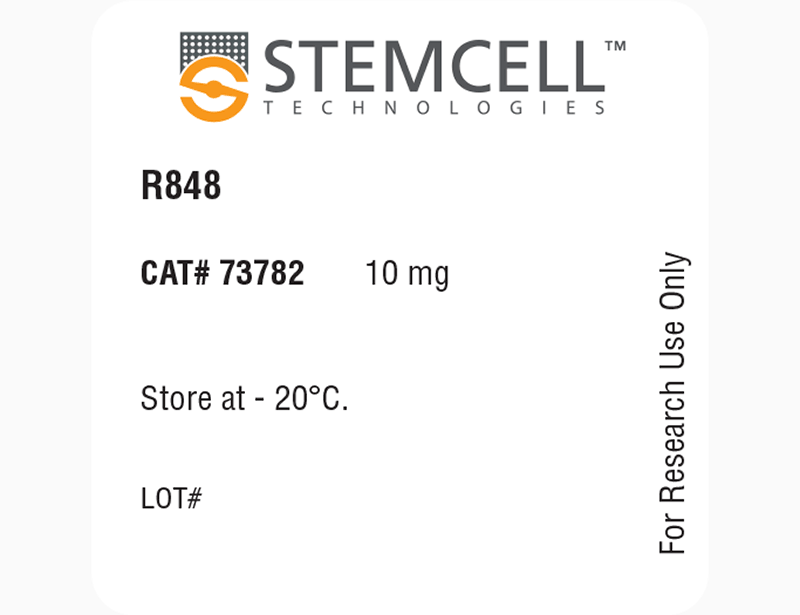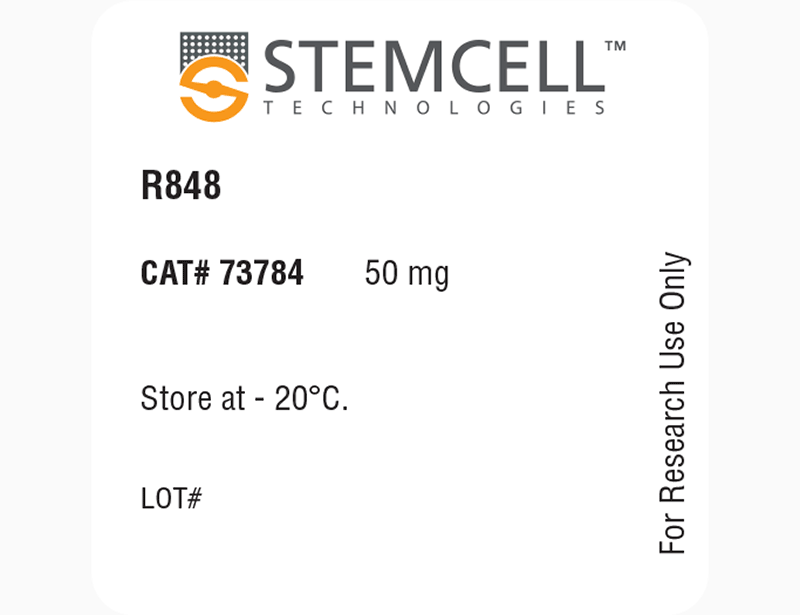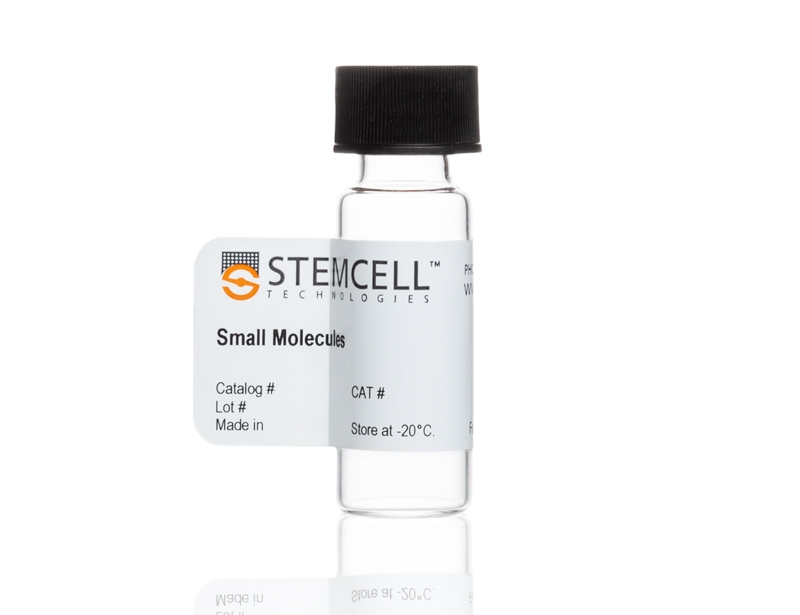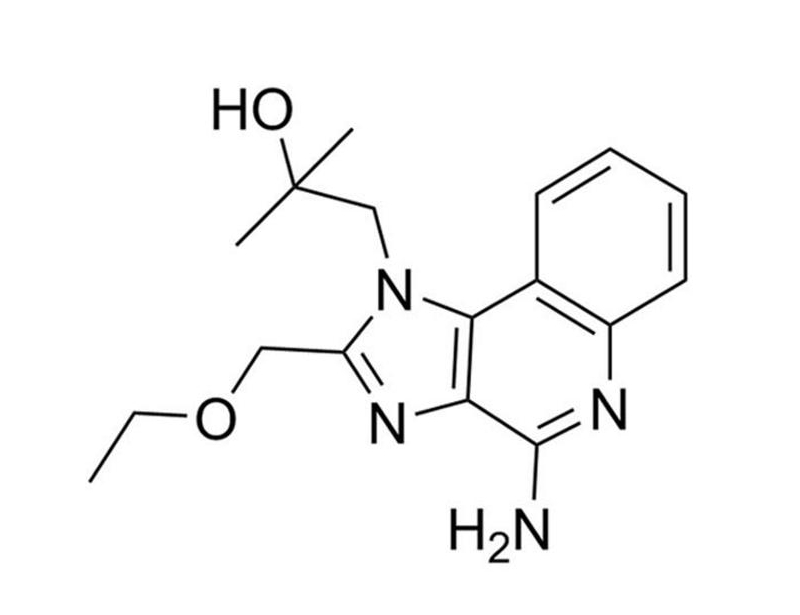R848
Immune modulator; TLR7 and TLR8 agonist
概要
R848 is an imidazoquinoline and agonist of Toll-like receptors (TLRs) 7 and 8. It mimics the pathogen-associated molecular patterns that activate immune cells through TLR7 and TLR8, and thereby acts as an immune-response modifier. It demonstrates potent anti-tumor and anti-viral properties (IC₅₀ = 4.2 μM; Seganish et al.) which appear to be mediated predominantly through the induction of cytokines, including interferon (IFN)-α and interleukin (IL)-12 due to stimulation of monocytes, macrophages, and dendritic cells (Bernstein et al.; Hattermann et al.; Nian et al.).
IMMUNOLOGY
· Triggers activation of human B cells, including activation of c-Jun kinase, p38 and NF-κB transcription factors (Bishop et al.).
· Induces proliferation and cytokine production by human CD4+ T cells (Caron et al.).
· Primes human neutrophils for leukotriene B4, prostaglandin E2, and platelet-activating factor biosynthesis (Hattermann et al.).
· Suppresses HIV-1 replication in monocytes (Nian et al.). · Induces expression of IL-12 and IFN-ɣ in mouse and human peripheral blood cell cultures (Wagner et al.).
DIFFERENTIATION
· Targets osteoclast precursors and inhibits their differentiation into osteoclasts via TLR7 (Miyamoto et al.).
· Induces myeloid differentiation of CD34+ hematopoietic progenitor cells, including upregulated expression of cytokines (IL-1β, TNF-α, IL-6, GM-CSF) and CD11c surface marker (Sioud et al.).
IMMUNOLOGY
· Triggers activation of human B cells, including activation of c-Jun kinase, p38 and NF-κB transcription factors (Bishop et al.).
· Induces proliferation and cytokine production by human CD4+ T cells (Caron et al.).
· Primes human neutrophils for leukotriene B4, prostaglandin E2, and platelet-activating factor biosynthesis (Hattermann et al.).
· Suppresses HIV-1 replication in monocytes (Nian et al.). · Induces expression of IL-12 and IFN-ɣ in mouse and human peripheral blood cell cultures (Wagner et al.).
DIFFERENTIATION
· Targets osteoclast precursors and inhibits their differentiation into osteoclasts via TLR7 (Miyamoto et al.).
· Induces myeloid differentiation of CD34+ hematopoietic progenitor cells, including upregulated expression of cytokines (IL-1β, TNF-α, IL-6, GM-CSF) and CD11c surface marker (Sioud et al.).
Alternative Names
Resiquimod; S 28463
Cell Type
B Cells, Granulocytes and Subsets, Hematopoietic Stem and Progenitor Cells, Monocytes, Osteoblasts, T Cells, T Cells, CD4+
Species
Human, Mouse, Rat, Non-Human Primate, Other
Application
Activation, Differentiation
Area of Interest
Immunology
CAS Number
144875-48-9
Chemical Formula
C₁₇H₂₂N₄O₂
Molecular Weight
314.4 g/mol
Purity
≥ 98%
Pathway
Innate Immunity
Target
TLR
技术资料
| Document Type | 产品名称 | Catalog # | Lot # | 语言 |
|---|---|---|---|---|
| Product Information Sheet | R848 | 73782, 73784 | All | English |
| Safety Data Sheet | R848 | 73782, 73784 | All | English |
数据及文献
Publications (10)
ACS medicinal chemistry letters 2015 AUG
Discovery and Structure Enabled Synthesis of 2,6-Diaminopyrimidin-4-one IRAK4 Inhibitors.
Abstract
Abstract
We report the identification and synthesis of a series of aminopyrimidin-4-one IRAK4 inhibitors. Through high throughput screening, an aminopyrimidine hit was identified and modified via structure enabled design to generate a new, potent, and kinase selective pyrimidin-4-one chemotype. This chemotype is exemplified by compound 16, which has potent IRAK4 inhibition activity (IC50 = 27 nM) and excellent kinase selectivity (textgreater100-fold against 99% of 111 tested kinases), and compound 31, which displays potent IRAK4 activity (IC50 = 93 nM) and good rat bioavailability (F = 42%).
Cytotechnology 2012 MAY
R848, a toll-like receptor 7 agonist, inhibits osteoclast differentiation but not survival or bone-resorbing function of mature osteoclasts.
Abstract
Abstract
R848, also known as resiquimod, acts as a ligand for toll-like receptor 7 (TLR7) and activates immune cells. In this study, we examined the effects of R848 on differentiation, survival, and bone-resorbing function of osteoclasts. R848 inhibited osteoclast differentiation of mouse bone marrow-derived macrophages (BMMs) and human peripheral blood-derived monocytes induced by receptor activator of NF-κB ligand in a dose-dependent manner. In addition, it inhibited mouse osteoclast differentiation induced in cocultures of bone marrow cells and osteoblasts in the presence of dihydroxyvitamin D(3) [1,25(OH)(2)D(3)]. However, R848 did not affect the survival or bone-resorbing activity of mouse mature osteoclasts. R848 also upregulated the mRNA expression levels of interleukin (IL)-6, IL-12, interferon (IFN)-γ, and inducible nitric oxide synthase in mouse BMMs expressing TLR7. IFN-β was consistently expressed in the BMMs and addition of neutralizing antibodies against IFN-β to the cultures partially recovered osteoclast differentiation inhibited by R848. These results suggest that R848 targets osteoclast precursors and inhibits their differentiation into osteoclasts via TLR7.
BMC infectious diseases 2012 JAN
R-848 triggers the expression of TLR7/8 and suppresses HIV replication in monocytes.
Abstract
Abstract
BACKGROUND Toll-like receptors (TLR) 7 and 8 are important in single-stranded viral RNA recognition and may play a role in HIV infection and disease progression. We analyzed TLR7/8 expression and signaling in monocytes from HIV-infected and uninfected subjects to investigate a pathway with new potential for the suppression of HIV replication. METHODS Eighty-one HIV-infected and uninfected subjects from Liaoning and Henan provinces in China participated in this study. Monocytes were isolated from subjects' peripheral blood mononuclear cells by magnetic bead selection. TLR7 and TLR8 mRNA was measured using quantitative real-time reverse transcriptase PCR. R-848 (resiquimod) was used as a ligand for TLR7 and TLR8 in order to 1) assess TLR7/8-mediated monocyte responsiveness as indicated by IL-12 p40 and TNF-α secretion and 2) to examine HIV replication in cultured monocytes in the presence of R-848. RESULTS We found that expression of TLR7/8 mRNA in peripheral blood monocytes decreased with disease progression. TLR7 expression was decreased with stimulation with the TLR7/8 agonist, R-848, in vitro, whereas TLR8 expression was unaffected. Following R-848 stimulation, monocytes from HIV-infected subjects produced significantly less TNF-α than those from uninfected subjects, but trended towards greater production of IL-12 than stimulated monocytes from uninfected subjects. R-848 stimulation also suppressed HIV replication in cultured monocytes. CONCLUSIONS Our study provides evidence that the TLR7 and TLR8 triggering can suppress HIV replication in monocytes and lead to postpone HIV disease progression, thereby offering novel targets for immunomodulatory therapy.
FASEB journal : official publication of the Federation of American Societies for Experimental Biology 2007 MAY
The Toll-like receptor 7/8-ligand resiquimod (R-848) primes human neutrophils for leukotriene B4, prostaglandin E2 and platelet-activating factor biosynthesis.
Abstract
Abstract
Toll-like receptors (TLR) recognize pathogen-associated molecular patterns and play important roles in the innate immune system. While single-stranded viral RNA is the natural ligand of TLR7/TLR8, the imidazoquinoline resiquimod (R-848) is recognized as a potent synthetic agonist of TLR7/TLR8. We investigated the effects of TLR7/8 activation on lipid mediator production in polymorphonuclear leukocytes exposed to R-848. Although R-848 had minimal effects by itself, it strongly enhanced leukotriene B4 formation on subsequent stimulation by fMLP, platelet-activating factor, and the ionophore A23187. R-848 acted via TLR8 but not TLR7 as shown by the lack of effect of the TLR7-specific ligand imiquimod. Priming with R-848 also resulted in enhanced arachidonic acid release and platelet-activating factor formation following fMLP stimulation, as well as enhanced prostaglandin E2 synthesis following the addition of arachidonic acid. Western blot analysis demonstrated that R-848 induced the phosphorylation of the cytosolic phospholipase A2alpha, promoted 5-lipoxygenase translocation and potently stimulated the expression of the type 2 cyclooxygenase. Bafilomycin A1, an inhibitor of endosomal acidification, efficiently inhibited all R-848-induced effects. These studies demonstrate that TLR8 signaling strongly promotes inflammatory lipid mediator biosynthesis and provide novel insights on innate immune response to viral infections.
Journal of molecular biology 2006 DEC
Signaling through toll-like receptor 7/8 induces the differentiation of human bone marrow CD34+ progenitor cells along the myeloid lineage.
Abstract
Abstract
Toll-like receptors (TLRs) play a key role in pathogen recognition and regulation of the innate and adaptive immune responses. Although TLR expression and signaling have been investigated in blood cells, it is currently unknown whether their bone marrow ancestors express TLRs and respond to their ligands. Here we found that TLRs (e.g. TLR4, TLR7 and TLR8) were expressed by freshly isolated human bone marrow (BM) hematopoietic CD34+ progenitor cells. Incubation of these primitive cells with TLR ligands such as immunostimulatory small interfering RNAs and R848, a specific ligand for TLR7/8, induced cytokine production (e.g. IL1-beta, IL6, IL8, TNF-alpha, GM-CSF). Moreover, TLR7/8 signaling induced the differentiation of BM CD34+ progenitors into cells with the morphology of macrophages and monocytic dendritic precursors characterized by the expression of CD13, CD14 and/or CD11c markers. By contrast, R848 ligand did not induce the expression of glycophorin A, an early marker for erythropoiesis. Collectively, the data indicate for the first time that human BM CD34+ progenitor cells constitutively express functional TLR7/TLR8, whose ligation can induce leukopoiesis without the addition of any exogenous cytokines. Thus, TLR signaling may regulate BM cell development in humans.
Journal of immunology (Baltimore, Md. : 1950) 2005 AUG
Direct stimulation of human T cells via TLR5 and TLR7/8: flagellin and R-848 up-regulate proliferation and IFN-gamma production by memory CD4+ T cells.
Abstract
Abstract
TLRs are involved in innate cell activation by conserved structures expressed by microorganisms. Human T cells express the mRNA encoding most of TLRs. Therefore, we tested whether some TLR ligands may modulate the function of highly purified human CD4+ T lymphocytes. We report that, in the absence of APCs, flagellin (a TLR5 ligand) and R-848 (a TLR7/8 ligand) synergized with suboptimal concentrations of TCR-dependent (anti-CD3 mAb) or -independent stimuli (anti-CD2 mAbs or IL-2) to up-regulate proliferation and IFN-gamma, IL-8, and IL-10 but not IL-4 production by human CD4+ T cells. No effect of poly(I:C) and LPS, ligands for TLR3 and TLR4, respectively, was detected. We also observed that CD4+CD45RO+ memory T cell responses to TLR ligands were more potent than those observed with CD4+CD45RA+ naive T cells. Moreover, among the memory T cells, CCR7- effector cells were more sensitive to TLR ligands than CCR7+ central memory cells. These data demonstrate for the first time a direct effect of TLR5 and TLR7/8 ligands on human T cells, and highlight an innate arm in T cell functions. They also suggest that some components from invading microorganisms may directly stimulate effector memory T cells located in tissues by up-regulating cytokine and chemokine production.




